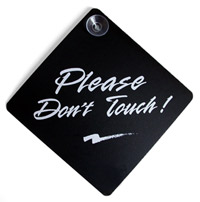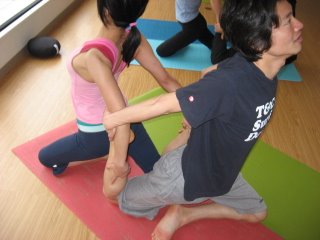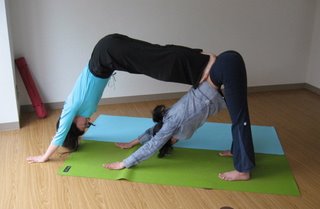
A salaryman was waiting at the corner for the light to change, and another guy in a windbreaker on a bicycle clipped the salaryman. The salaryman started yelling at the windbreaker guy, and kicked the bicycle. The windbreaker guy cuffed the salaryman on the back of the head, and at that moment the salaryman sensed this guy was a loose cannon and walked away cursing. The windbreaker guy threw his bicycle to the ground and stalked after the salaryman with a murderous glint in his eye. At that point they had walked out of the sightline of the window to the sidewalk in front of the building.
Gwen and I had a choice then, although things happened so quickly we didn't really recognize it as that. The incident had happened outside, through a window, and the two men were now in the front of the building, where there were about 20 other cafe customers, a park, and a busy sidewalk. It was out of our hands, right?
If you've spent any time in a psychology class you'll have heard of the "bystander effect." The idea is that in an emergency situation where someone is in danger, the more people that are around, the less likely that anyone will help that person. There are many famous (and sad) cases, where someone is attacked in a very public place (an apartment buildings front steps, on a busy bridge) and no one stops to help or even call the police. I had a psychology teaching assistant, who once, in the middle of the lecture, was suddenly attacked by another teacher. The attacker threw him to the ground and they kicked and fought their way out into the hall. In our lecture room of about 100 people, no one moved a muscle, we were frozen in our seats. The teaching assistant came back in a few minutes later and revealed that it had all been an act, and that frozen, "what's going on?" feeling was the bystander effect. This effect happens to everyone, no matter how "good" or "brave" a person you are.
But what was interesting in this story is that Gwen and I didn't really think about it, and went into action. I went to the front of the building while Gwen got the staff to call the police. Out on the sidewalk, the windbreaker guy had just caught up to the salaryman, and all the cafe patrons were watching them swear and scream at each other. The windbreaker guy suddenly grabbed the salaryman by the throat, threw him into a bush, and was squeezing his windpipe with one hand and strangling the salaryman with his own tie with the other! I ran over to them and pulled the windbreaker guy off the salaryman, but his grip on the necktie was so tight that all three of us kind of lurched out of the bush. I told the attacker to relax, that it was a small problem, nothing to get upset about, and peeled his fingers off the necktie. The two men were eerily quiet, just staring at each other with hatred. I was afraid to let go of them, or they might start trying to kill each other again. The police arrived shortly and broke it up, took all of our statements, and that was that.
I was thinking about it later, about how it had been a perfect example of the bystander effect. There were a dozen people closer to the guys than we were, but no one else moved a muscle, just like that psychology class. What made Gwen and I act so decisively? Neither of us is particularly brave or eager to "save the day," and we don't even speak Japanese that well, especially all that emergency vocabulary that you should learn but never bother to. Like everyone else there, we just wanted to relax and enjoy our coffee. What I concluded is that the difference between us and the rest of the crowd there is that we do a lot of yoga and meditation.
One of the lessons of yoga is to relax and accept unfamiliar situations. In half-moon pose, for example, your body weight is one hand and one leg.
 Your body wants to come down and touch the floor with another limb for stability, and, if you are new to the pose, that is exactly what happens. But, after a few tries, you find that relaxing, breathing, and accepting the strange position makes it much easier. If you do poses like that a few times a week, maybe your brain structure starts to change, and instead of an instinct to run away or deny strange situations, you stay with them and see where they lead.
Your body wants to come down and touch the floor with another limb for stability, and, if you are new to the pose, that is exactly what happens. But, after a few tries, you find that relaxing, breathing, and accepting the strange position makes it much easier. If you do poses like that a few times a week, maybe your brain structure starts to change, and instead of an instinct to run away or deny strange situations, you stay with them and see where they lead.The other thing is meditation, which teaches you to be in the moment, not clinging to the past or future. When I saw those guys my only thought was that I had to stop them in that moment. It made doing the right thing very natural and easy. Again, I want to stress that I am not a particularly good person! My reaction was just different from the other people there.
Buddhism teaches the 8 fold path as a method to overcome suffering and make your way on your spiritual journey. The 4th limb of this path is "skillful action," that is, using the energy of your actions skillfully, to bring about understanding and to do no harm. One of the nice things about meditation and yoga is that they change you on a very deep level, slowly and over time. It doesn't require much rigour, just small, daily steps. And you'll see changes in yourself, sometimes very suddenly, as I did when I was pulling that oxygen deprived business man from the bushes. So keep practicing everyone! If you like, consider it training for the time when you will need to act decisively, skillfully, and for the good of someone else.
Patrick
Yoga Garden






